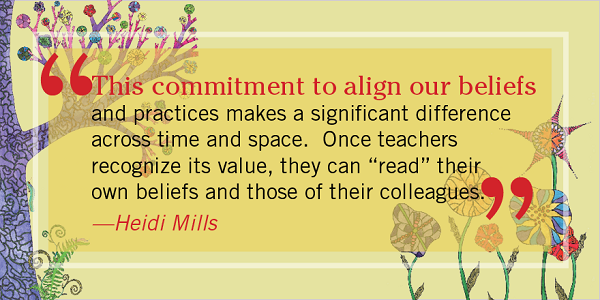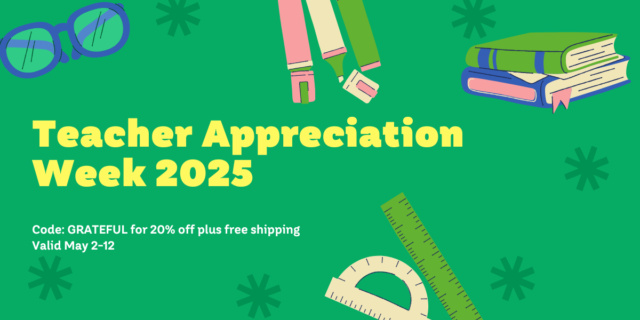
Welcome to the Heinemann Professional Development Professional Learning Community (PLC) series. Each month, we'll share a post designed to provoke thinking and discussion through a simple framework, incorporating mini-collections of linked content.
Use these as learning modules during your professional development time, whether in a team, a PLC, or on your own!
by Jaclyn Karabinas
♦♦♦♦
![]() Connect
Connect
Let’s begin thinking about aligning beliefs and practices not within the classroom, but in your personal life. Can you name something you routinely do because you believe it has a positive impact on long-term quality of life?
Consider
The students in our lives will be ever-changing and widely diverse young humans. If we make it a regular practice to revisit, reflect upon, and reexamine belief systems—individually and collectively—then we can be sure we are striving to make thoughtful decisions that positively impact all of our students.
Read this short excerpt by José Vilson from his essay “A Call to Lock Arms” in The Teacher You Want to Be: Essays About Children, Learning, and Teaching (2015).
At the end of the excerpt he asks: “Why do we hold so tightly to the rigid ideas of what teaching used to look like and work with the generation of students we currently do, with different, valid values and diverse understandings of the way the world works?”
Hold on to this Guiding Question as you continue this work with aligning beliefs and practices: Do your belief systems support success in the world for the students in front of you? Not the students you wish you had—your students? All of them?
![]()
Educate
Watch this video clip with A Mindset for Learning authors Christine Hertz and Kristine Mraz where they talk about the classroom as “a microcosm of the world.” Be sure to note anything that nags at you, a statement that challenges your current practices, or an idea that you wish to explore further.
![]()
Reflect
Look at a class picture or roster of the students you currently work with each day. Using a list, make notes next to each name about their general strengths and struggles that dominate their school experience.
Now it’s time to look for patterns and evidence of practices that either benefit all students or beg for a closer look. While you could certainly do this alone, examining the list and having conversations with other educators can help you to clearly express and name your observations.
For example: Do you list a number of students who struggle with the give-and-take of conversation? Do you note a handful of students who regularly do not turn in homework? Do you see a pattern of students who are “good at school”, who are possibly compliant but not engaged? Do your notes show that students enjoy and thrive in an environment of choice?
![]()
Practice
Now that you have identified a pattern, link it back to a belief system. Be ready to be uncomfortable—it will not always align! Lean into the discomfort. Author Sara Ahmed reminds us that discomfort is where learning happens.
For example: If you say you believe that homework is one way to encourage responsibility, but the students who regularly do turn it in are typically compliant and good at school, is it achieving the goal you thought aligned with your beliefs? Can you find a pattern in the students who struggle with this?
If you say that students thrive when there is choice and you believe in the power of choice, yet they are always required to begin the school day with a list of “Do Nows” or “Morning Work” activities, are you really inviting that belief into the time of day that sets the stage for learning?
If you say that you want your students to exhibit positive behavior because you believe self-regulation is a life skill for success, but you rely on clip charts or rewards, do your practices match your beliefs?
![]()
Extend
If you found yourself trying to make excuses for any misaligned practices—congratulations! You are human. We need to be willing to revisit our beliefs and practices regularly as we will encounter different students every year. New questions, biases, and preconceived notions will pop up every time.
Perhaps you found a practice you want to change so it aligns with your beliefs OR you discovered a belief that does not serve all of your students—now what?
Watch this video blog from Tom Newkirk where he talks about how we sometimes shy away from making change because we are embarrassed to ask for help or fear that catastrophe will ensue if we make an error when pursuing change.
![]()
Refine
Return to the guiding question: Do your belief systems support success in the world for the students in front of you?
Make the time to address a misalignment you uncovered by talking with colleagues, reading, journaling, kidwatching, and reflecting. Read How to (Re)Integrate Your Beliefs Into Your Curriculum by Kristine Mraz for an example of how to move through this process of re-aligning beliefs.
![]()
Act
Aim to make this change as a team, a partnership, or at the least have a colleague willing to hold you accountable to support your thinking process. Take these words with you from Heidi Mills’ essay “Why Beliefs Matter” in The Teacher You Want to Be to remind you of this ongoing goal and why this matters for students.

For Further Reading:
- PLC Post January, 2018: “Making Shifts in Our Inner Voices”
- “Some Thoughts on Clip Charts” by Kristine Mraz
- Excerpt: “Making a Place for Spencer: Placemaking as a Political Act” by Stephanie Jones from The Teacher You Want to Be (2015).
- “If I Knew Then What I Know Now: Mistaking Compliance For Learning” by Jaclyn Karabinas



